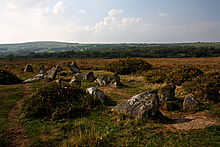|
|
|
|
BeddyrafancBurial Chamber
|
|
|
|
Images (click to view fullsize) |
|
Photographs:












 Maps / Plans / Diagrams:
Maps / Plans / Diagrams:
|
Fieldnotes |
|
|
I left the car in Kammers green dot (ironicaly its just yards from a sign for Pentre Ifan, see map) of a parking place but didnt take the advice of taking the footpath, it doesnt go near the cairn anyway, instead I took the more direct route of following the river from the road, up a driveway then skirt round the property and head for higher dryer ground, my more or less hit and miss approach paid good dividends as I spotted the only likely looking stones poking above the tufts of Gorse, so I walked straight up to it dodging the inevitable boggy bits, no problems at all. I liked this place a lot, the stones arent massive and they arent aligned on anything, but they managed to steal the show, Carreg Sampson can keep it's stonking great capstone i'm happiest here this morning. The hillside sweeps high and steep to the south with Carns gallore, and all around is open moor thats strangely vibrant in colour. I'm reminded wistfully of Brittany. |
 Posted by postman
Posted by postman13th March 2010ce Edited 14th April 2012ce |
|
Visited 9th July 2005: This is not an easy site to find. For directions detailing how to get to Bedd yr Afanc, take a look at my map and notes. We were blessed with glorious sunshine. The heat was almost too much really. I had Emily (less than two weeks old) in sling on my front and Lou was supervising the boys. We trudged our way to the site. It felt a bit like a scene out of Beau Geste. Bedd yr Afanc is a modest site, especially when compared to it's nearest neighbour Pentre Ifan. Having seen photos of the site I knew what to expect, but there's a danger of disappointment if you're expecting something like a Breton gallery grave. I wondered about for a while trying to figure out where the capstones could have ended up, and found one large stone a few metres away from the tomb. Assuming that this is a capstone, why would anyone come to this place and shift a stone that large only a few metres? Bedd yr Afanc is definitely worth a visit if you're an enthusiast, but is probably not worth the walk if you only have a casual interest in prehistory. The terrain is relatively level, but by no means wheelchair friendly. |
 Posted by Kammer
Posted by Kammer21st July 2005ce Edited 21st July 2005ce |
Folklore |
|
Bedd yr Afanc, 'the Afanc's Grave, [is] the name of some sort of a tumulus, I am told, on a knoll near the Pembrokeshire stream of the Nevern.Aw just give over, let it be a water monster, that's much more interesting. The grave is long and the monster is long. From Rhys's 1901 'Celtic Folklore Welsh and Manx', online at the Sacred Texts Archive http://www.sacred-texts.com/neu/cfwm/cf207.htm also see this page for more details (about the Peredur story, for instance): http://www.sacred-texts.com/neu/cfwm/cf201.htm |
 Posted by Rhiannon
Posted by Rhiannon6th November 2006ce Edited 14th March 2010ce |
I always imagined the Afanc as a bit like a watery dragon. But it seems he could talk and wield a spade:A North Pembrokeshire legend says that in ancient days the Afanc, dwelling on the Precelly slopes somewhere above Brynberian, ravaged the countryside, committing such depredations on the live-stock of the population that a consultation of the wisest folk was held to devise some means of getting rid of him. They decided to slay him by a trick. A deputation was sent to him to ask him to dig a well for the people. This he agreed to do, and forthwith began working furiously. When he had dug to a great depth ("over one hundred yards" said one relater) the people above tipped into the hole he had made a big load of "white stones" {? Alabaster} which they had collected on the mountain-sides, intending to crush him to death. But next morning they found him still digging, and were informed by him that there had been a rather heavy snowstorm on the previous day. Thus they were unable to do away with him; and he continued as before, eventually "dying a natural death", after which "he was buried on the hill side" between Hafod and Brynberian, "and his tomb {a cairn of stones} may be seen to this day". In June, 1928 Charles Oldham and I visited this stone circle which is close to the village of Brynberian, well out on the moor.Notes on Pembrokeshire Folk-Lore, Superstitions, Dialect Words, etc Bertram Lloyd Folklore, Vol. 56, No. 3. (Sep., 1945), pp. 307-320. |
 Posted by Rhiannon
Posted by Rhiannon5th October 2006ce Edited 5th October 2006ce |
| Bedd yr Afanc means 'grave of the water monster'. This area is full of streams, and the water monster used to live in a pool near the bridge over the Brynberian river. The local people didn't like him for some reason, so he was killed and buried in this mound. The long low oval mound/cairn is a 'gallery grave'. No capstones survive of the chamber, but you can see a long low passage of ten pairs of ~50cm uprights leading to a small circular chamber made by seven stones. The site nestles below the Preseli Mountains, where the bluestones for Stonehenge originated. |
 Posted by Rhiannon
Posted by Rhiannon21st June 2002ce Edited 8th July 2005ce |

